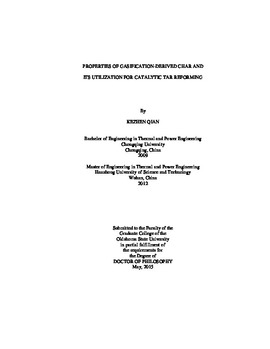| dc.contributor.advisor | Kumar, Ajay | |
| dc.contributor.author | Qian, Kezhen | |
| dc.date.accessioned | 2016-09-29T18:36:32Z | |
| dc.date.available | 2016-09-29T18:36:32Z | |
| dc.date.issued | 2015-05 | |
| dc.identifier.uri | https://hdl.handle.net/11244/45200 | |
| dc.description.abstract | Char is a low-value byproduct of biomass gasification and pyrolysis with many potential applications, such as soil amendment and the synthesis of activated carbon. The overall goal of the proposed research was to develop novel methods to use char derived from gasification for high-value applications in syngas conditioning. The first objective was to investigate effects of gasification condition and feedstock on properties of char derived from fluidized bed gasification. Results show that the surface areas of most of the char were 1-10 m2/g and increased as the equivalence ratio increased. Char moisture and fixed carbon contents decreased while ash content increased as equivalence ratio increased. The next objective was to study the properties of sorghum and red cedar char derived from downdraft gasifier. Red cedar char contained more aliphatic carbon and o-alkyl carbon than sorghum char. Char derived from downdraft gasification had higher heating values and lower ash contents than char derived from fluidized bed gasification. The gasification reactivity of red cedar char was higher than that of sorghum char. Then, red cedar char based catalysts were developed with different preparation method to reform toluene and naphthalene as model tars. The catalyst prepared with nickel nitrate was found to be better than that with nickel acetate. The nickel particle size of catalyst impregnated with nickel nitrate was smaller than that of catalyst impregnated with nickel acetate. The particle size of catalyst impregnated with nickel acetate decreased by hydrazine reduction. The catalyst impregnated with nickel nitrate had the highest toluene removal efficiency, which was 70%-100% at 600-800 degrees C. The presence of naphthalene in tar reduced the catalyst efficiency. The toluene conversion was 36-99% and the naphthalene conversion was 37%-93% at 700-900 degrees C. Finally, effects of atmosphere and pressure on catalytic reforming of lignin-derived tars over the developed catalyst were investigated. An increase in reaction temperature led to an increase in removal of most tar components except naphthalene. High pressure promoted the catalytic conditioning of lignin tar. Hydrogen promoted the conversion of lignin into non-condensable gas. | |
| dc.format | application/pdf | |
| dc.language | en_US | |
| dc.rights | Copyright is held by the author who has granted the Oklahoma State University Library the non-exclusive right to share this material in its institutional repository. Contact Digital Library Services at lib-dls@okstate.edu or 405-744-9161 for the permission policy on the use, reproduction or distribution of this material. | |
| dc.title | Properties of gasification-derived char and its utilization for catalytic tar reforming | |
| dc.contributor.committeeMember | Bellmer, Danielle | |
| dc.contributor.committeeMember | Wilkins, Mark | |
| dc.contributor.committeeMember | Zhang, Hailin | |
| osu.filename | Qian_okstate_0664D_14007.pdf | |
| osu.accesstype | Open Access | |
| dc.type.genre | Dissertation | |
| dc.type.material | Text | |
| thesis.degree.discipline | Biosystems and Agricultural Engineering | |
| thesis.degree.grantor | Oklahoma State University | |
